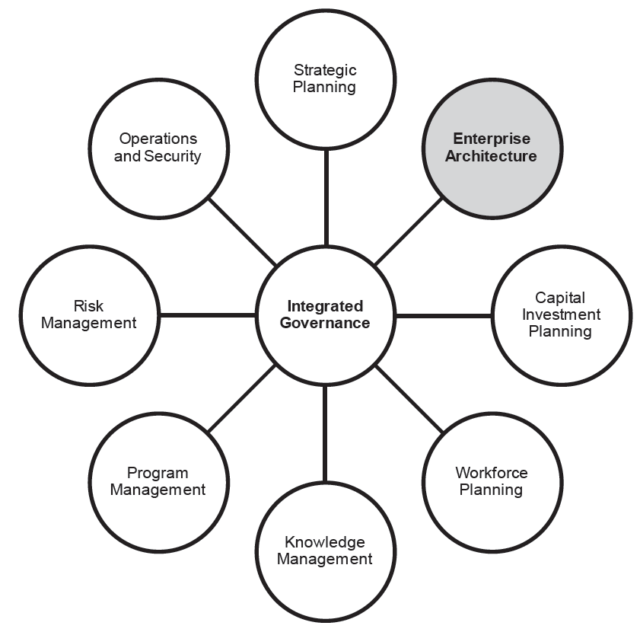Enterprise Architecture
Enterprise Architecture is a management and technology practice that is devoted to improving the performance of enterprises by enabling them to see themselves in terms of a holistic and integrated view of their strategic direction, business practices, information flows, and technology resources. By developing current and future versions of this integrated view, an enterprise can better manage the transition from current to future operating methods. This transition includes the identification of new goals, activities, and all types of capital and human resources (including information technology) that will improve bottom line financial and mission performance.
The strategic use of resources is increasingly important to the success of public and private sector enterprises, including extended enterprises involving multiple internal and external participants (e.g., supply chains). How to get the most from business, technology, and human resources requires an enterprise to think in terms of enterprise-wide solutions, rather than individual system development projects. Doing this requires a new approach to planning and systems development, an approach that has come to be known as Enterprise Architecture (EA). The word ‘enterprise’ implies a high-level, strategic view of the entire organization, while the word ‘architecture’ implies a structured framework for the analysis, planning, and development of all types of resources.
EA = S + B + T
Enterprise Arcitecture = Strategy + Business + Techology
This brief introduction provides an overview of the discipline of Enterprise Architecture (EA). EA is a strategy and business-driven activity that supports management planning and decision-making by providing coordinated views of an entire enterprise. These views encompass strategy, business, and technology, which is different from technology-driven, systems-level, or process centric approaches. Implementing an EA involves core elements, a management program, and a framework-based documentation method.
EA is primarily about designing virtual things – organizations and their capabilities, whereas traditional architecture is primarily about designing physical things. There are many parallels in these two disciplines and there are a number of intersecting areas such as creating work environments that promote productivity and support agility. EA is both a noun and a verb. The architecture of an enterprise is a thing – a collection of models and information. Creating an enterprise-wide architecture is accomplished through a standardized process that is sustained through an ongoing management program. EA provides a strategy and business-driven approach to policy, planning, decision making, and resource development that is useful to executives, line managers, and support staff. To be effective, an EA program must be part of a group of management practices that form an integrated governance structure, as is shown in this figure
References
Scott A. Bernard . (2012).An Introduction to Enterprise Architecture . 03 th Edition. Authorhouse. Bloomington. ISBN: 978-1-4772-5800-2 .


